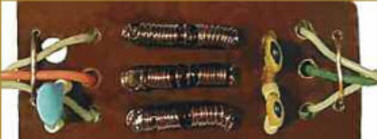
|
|
ENCYCLOPEDIA OF RADIO ELECTRONICS AND ELECTRICAL ENGINEERING External telescopic antenna for mobile devices. Encyclopedia of radio electronics and electrical engineering
Encyclopedia of radio electronics and electrical engineering / VHF antennas Many mobile multimedia devices (cell phones, MP-3 players, e-books, navigators) incorporate a VHF FM radio receiver, which allows them to listen to local VHF radio broadcasts. The antenna is usually the wire of the connected stereo telephones. In conditions of a weak radio signal, you have to carefully choose the position of this wire for stable radio reception, which creates great inconvenience. To improve the quality of reception and increase the convenience of using these devices in stationary conditions as radio receivers, it is enough to make a simple external antenna for them.
A diagram of a device for connecting an external antenna to mobile devices is shown in fig. 1. XS1 jack is connected to the mobile device's stereo phone jack, and the stereo phones themselves (or the input of the AF power amplifier) are connected to the XS2 jack. Chokes L1-L4 and capacitors C2, C3 minimize the effect on radio reception of the connecting cable connected to XS2. This allows, for example, to move around the room with stereo phones without disrupting radio reception or to lay a signal wire to the amplifier along an arbitrary route. Capacitor C1 serves to galvanically isolate the telescopic antenna WA1 from the mobile device, which reduces the likelihood of damage, for example, due to the short circuit of the extended telescopic antenna on the metal case of the amplifier.
The details of the device are mounted on a board with dimensions of 47x22 mm made of fiberglass (Fig. 2). Inductors L1-L3 are frameless and contain 20 turns of wire with a diameter of 0,15 mm in enamel insulation, wound on a mandrel with a diameter of 2,5 mm. Inductor L4- 1 ... 3 turns of a triple-folded mounting wire wound on a ferrite ring with a diameter of 7.12 mm (a ferrite cup from the IF filter coil of an old transistor radio is also suitable). Capacitors - any ceramic small-sized (C1 preferably high-voltage). Inductors L1-L3 are glued to the board with BF-2 glue.
The basis of the design is a round plastic case from a replaceable filter "Barrier" designed for water purification (Fig. 3). Before disassembly, water is poured into it, allowed to flow out, after which it is opened from the side of water inflow and all contents are removed. Telescopic antenna - with a swivel locking mechanism. Such antennas were used, for example, in domestic portable televisions "Youth", "Sapphire". The antenna is fixed in the upper (according to Fig. 3) part of the body. Since it is thin-walled, its upper wall is “reinforced” from the inside with a washer with an outer diameter slightly smaller than the inner diameter of the body, cut from 3 mm thick polystyrene sheet. The washer is glued with hot glue and additionally fixed with a nut for fastening the antenna swivel mechanism. Jacks XS1, XS2 - standard for audio plug with a diameter of 3,5 mm. The use of two plug-in connections reduces the chance of damage to the equipment, for example, if you accidentally trip the signal wire with your foot. The sockets are glued to the case from the inside from opposite sides, the mounted board is in its upper part. The length of the wires connecting the board to socket XS1 and to the telescopic antenna must be kept to a minimum. The desktop stand for the case is a circle with a diameter of about 100 mm, cut out of polystyrene sheet 3,5 mm thick. A steel bushing weighing about 300 g is fixed in its center, which prevents the structure from tipping over when the telescopic antenna is extended at an angle to its full length. The case is attached to the stand with six self-tapping screws. The input jack of the device is connected to the multimedia device with a shielded two-wire cable up to 300 mm long. Since its braided shield is part of the VHF antenna, the position of the cable can also affect the quality of radio reception. The length of the wire connecting the device to stereo phones or an AF amplifier is of no fundamental importance; it has almost no effect on the stability of radio reception. Author: A. Butov
The world's tallest astronomical observatory opened
04.05.2024 Controlling objects using air currents
04.05.2024 Purebred dogs get sick no more often than purebred dogs
03.05.2024
▪ Consciousness exists separately from the brain ▪ Molex's New High Speed USB Cable Assemblies ▪ HPP845 - digital and analog humidity sensors TE Connectivity ▪ Artificial photosynthesis for fuel
▪ site section Frequency synthesizers. Selection of articles ▪ article Triumph of the Will. Popular expression ▪ article Where is the railway laid, in the train cars of which oxygen is supplied? Detailed answer ▪ article The functional composition of Vestel TVs. Directory ▪ article Name the map. Focus Secret
Home page | Library | Articles | Website map | Site Reviews www.diagram.com.ua |






 Arabic
Arabic Bengali
Bengali Chinese
Chinese English
English French
French German
German Hebrew
Hebrew Hindi
Hindi Italian
Italian Japanese
Japanese Korean
Korean Malay
Malay Polish
Polish Portuguese
Portuguese Spanish
Spanish Turkish
Turkish Ukrainian
Ukrainian Vietnamese
Vietnamese



 Leave your comment on this article:
Leave your comment on this article: